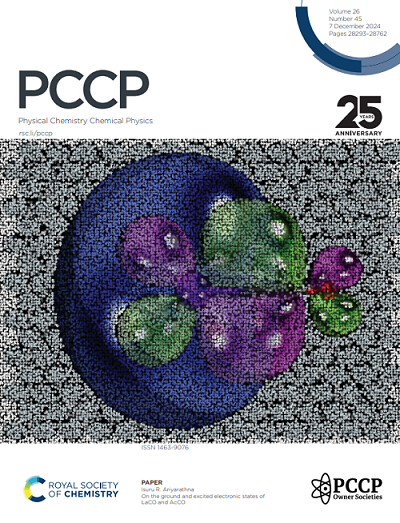Atomic insights into the ion-conducting channels of poly(arylene piperidinium) anion exchange membranes
IF 2.9
3区 化学
Q3 CHEMISTRY, PHYSICAL
引用次数: 0
Abstract
Anion exchange membranes (AEMs) are crucial in green energy devices such as water electrolyzers, fuel cells, and CO2 electroreduction. Among the reported AEMs, the quaternary ammonia poly(N-methyl-piperidine-co-p-terphenyl) (QAPPT) AEM is notable for its high OH− conductivity. However, the underlying mechanisms responsible for this high OH− conductivity have remained elusive. Recent experiments have developed the poly(p-quaterphenyl dimethyl piperidinium) (QAQPP) AEM, which has a similar structure to the QAPPT AEM but exhibits much lower conductivity. This discrepancy further complicates our understanding of the superior performance of the QAPPT AEM. To clarify the origin of QAPPT AEM's enhanced conductivity, we perform molecular dynamics simulations to investigate the differences in the underlying causes of the OH− conductivity between QAPPT and QAQPP AEMs. We observe higher OH− diffusion with larger ion-conducting channels in the QAPPT AEM, which is in good agreement with experimental results. Further analysis of the conformations with varying water contents shows that the ion-conducting channels in QAPPT AEMs become larger due to polymer chain folding and dispersion, thereby enhancing OH− transport. In contrast, the channels in QAQPP remain limited in size because the chains maintain their compactness regardless of the water content. Such pronounced conformational changes in QAPPT compared to QAQPP are essentially due to the greater sensitivity of its backbone phenyl rings to water. These findings highlight that conformational evolution in response to water is key to the enhanced conductivity of QAPPT AEMs, providing new insights for more efficient AEM design.

阴离子交换膜(AEM)在水电解器、燃料电池和二氧化碳电还原等绿色能源设备中至关重要。在已报道的 AEM 中,季氨聚合(N-甲基-哌啶-共对三联苯)(QAPPT)AEM 因其高 OH- 导电性而引人注目。然而,造成这种高羟基传导性的基本机制仍然难以捉摸。最近的实验开发出了聚对四联苯二甲基哌啶(QAQPP)AEM,其结构与 QAPPT AEM 相似,但电导率却低得多。这一差异进一步加深了我们对 QAPPT AEM 优异性能的理解。为了弄清 QAPPT AEM 导电性增强的原因,我们进行了分子动力学模拟,以研究 QAPPT 和 QAQPP AEM 之间 OH- 导电性的根本原因的差异。我们在 QAPPT AEM 中观察到更大的离子传导通道具有更高的 OH- 扩散,这与实验结果非常吻合。对不同含水量构象的进一步分析表明,QAPPT AEM 中的离子传导通道因聚合物链的折叠和分散而变大,从而增强了 OH- 的传输。相比之下,QAQPP 中的通道尺寸仍然有限,因为无论含水量如何,链都能保持紧密。与 QAQPP 相比,QAPPT 发生如此明显的构象变化主要是由于其骨架苯环对水的敏感性更高。这些发现突显了构象演化对水的响应是 QAPPT AEM 增强导电性的关键,为更有效的 AEM 设计提供了新的见解。
本文章由计算机程序翻译,如有差异,请以英文原文为准。
求助全文
约1分钟内获得全文
求助全文
来源期刊

Physical Chemistry Chemical Physics
化学-物理:原子、分子和化学物理
CiteScore
5.50
自引率
9.10%
发文量
2675
审稿时长
2.0 months
期刊介绍:
Physical Chemistry Chemical Physics (PCCP) is an international journal co-owned by 19 physical chemistry and physics societies from around the world. This journal publishes original, cutting-edge research in physical chemistry, chemical physics and biophysical chemistry. To be suitable for publication in PCCP, articles must include significant innovation and/or insight into physical chemistry; this is the most important criterion that reviewers and Editors will judge against when evaluating submissions.
The journal has a broad scope and welcomes contributions spanning experiment, theory, computation and data science. Topical coverage includes spectroscopy, dynamics, kinetics, statistical mechanics, thermodynamics, electrochemistry, catalysis, surface science, quantum mechanics, quantum computing and machine learning. Interdisciplinary research areas such as polymers and soft matter, materials, nanoscience, energy, surfaces/interfaces, and biophysical chemistry are welcomed if they demonstrate significant innovation and/or insight into physical chemistry. Joined experimental/theoretical studies are particularly appreciated when complementary and based on up-to-date approaches.
 求助内容:
求助内容: 应助结果提醒方式:
应助结果提醒方式:


